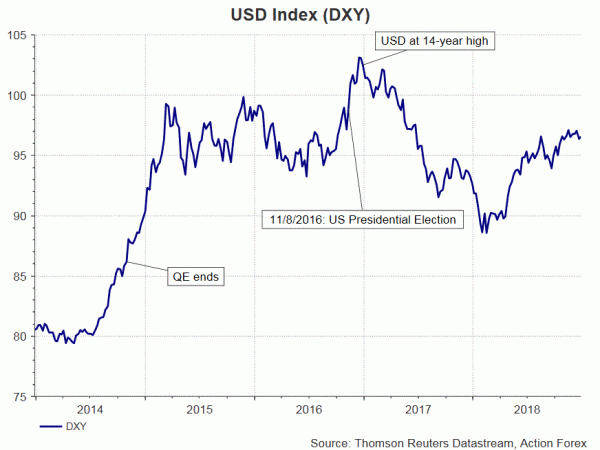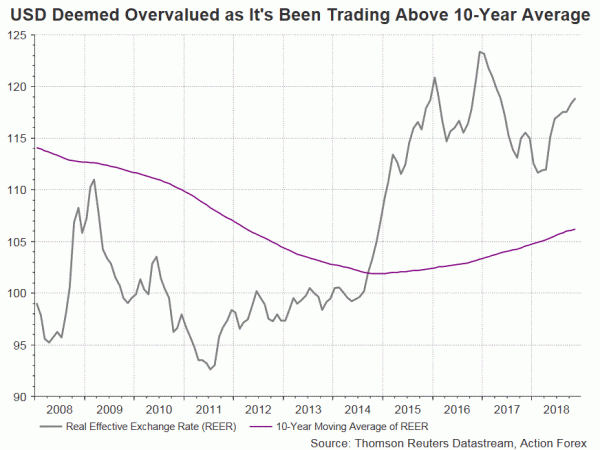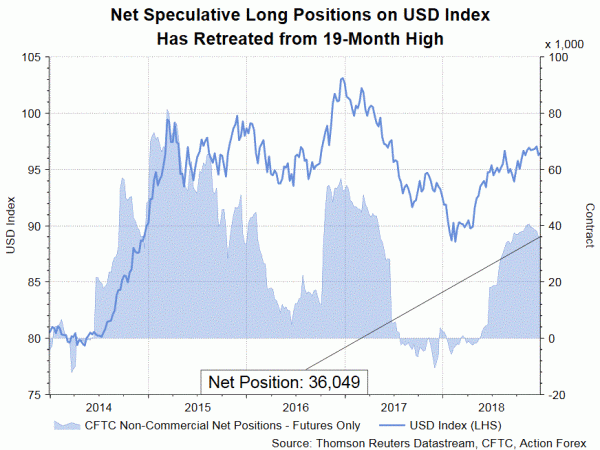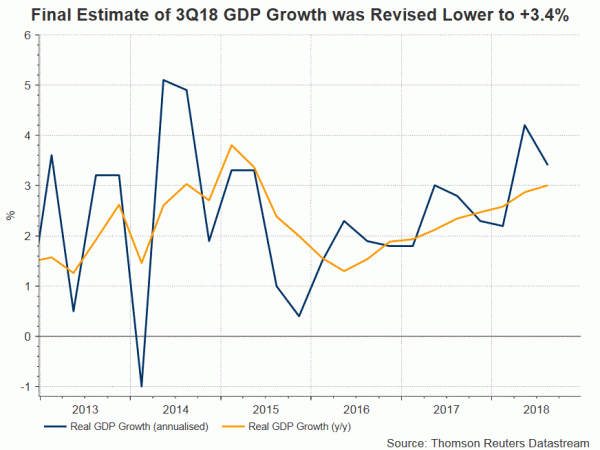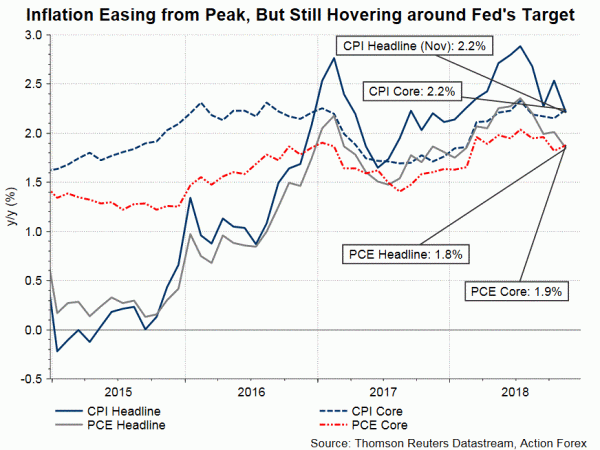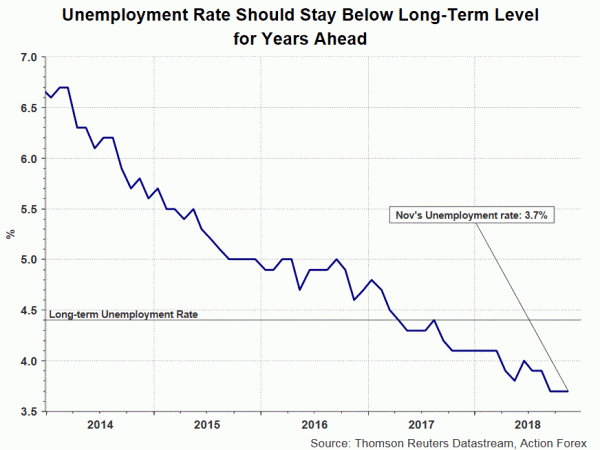The consensus forecast that USD’s rally, which began in February this year, is coming to an end hinges on the theses of overvaluation and stretched FX market longs, the slowdown in US economic growth and the end of current tightening cycle. While we are also of the view that the value of the greenback is probably peaking, we do not anticipate a sharp selloff in the coming year. Rather we expect it to fluctuate around high levels as the above-mentioned downside risks are partly offset by the upside risks. The factors supporting the greenback we identified include: above-trend US economic growth despite moderation. Fed’s rate high cycle remains intact despite slower pace and decision more data-dependent, USD’s risk-adjusted return remains attractive to risk averse investors, alongside Japanese yen and Swiss franc.
Market Consensus – USD Weakens Across the Board in 2019
| 4Q18F | 1Q19F | 2Q19F | 3Q19F | |
| EURUSD | 1.1400 | 1.1484 | 1.1708 | 1.1885 |
| GBPUSD | 1.2900 | 1.3201 | 1.3449 | 1.3601 |
| AUDUSD | 0.7285 | 0.7300 | 0.7333 | 0.7434 |
| NZDUSD | 0.6800 | 0.6758 | 0.6804 | 0.6892 |
| USDCAD | 1.3100 | 1.2999 | 1.2867 | 1.2766 |
| USDCHF | 1.0000 | 0.9966 | 0.9867 | 0.9766 |
| USDJPY | 113.00 | 111.83 | 111.09 | 109.82 |
Source: Thomson Reuters (as of Dec 5, 2018)
1. USD’s Overvaluation and Stretched Longs
US dollar index (DXY) has gained +3.5% so far this year, after plunging -9.5% in 2017. Currently trading at 96.98, DXY is hovering around the highest level in 18 months. IMF’s real effective exchange rate (REER) has also experienced similar price movements. Several models (IMF’s REER, OECD’s PPP exchange rate and mean reversion) have pointed to the notion that USD is overvalued.
IMF determines the fair value of a country’s exchange rate by considering a broad range of external indicators (including the current account, the real effective exchange rate, capital and financial accounts flows and measures, FX intervention and reserves and the foreign asset or liability position). It has been warning of USD’s overvaluation since 2015 (on 2014’s valuation). However, the DXY index continued to rise in both 2015 and 2016. Others suggested that the greenback is overvalued as its current value is about +10% higher than the 10-year average. Such a mean-version model believes that prices will revert back towards the mean or average over time.
The PPP model argues that exchange rates adjust to reflect the price differential between countries, so inflation differentials drive nominal exchange rates. While this might be true in the long-run, the actual exchange rate can derail from the “fair value” persistently in the short-run (several years). Moreover, this model, as well as the mean reversion model, assumes that the exchange rate would eventually return to a fixed, steady average level. However, this might not be true since exchange rate movements are driven by a many variables which are not necessarily logical.
Data from CFTC’s commitments of trader shows that the non-commercial net long positions for USD index have soared to 40 513 contract on the week of November 15, highest since the week of April 27, 2017. Some have raised concerns that the selloff of the greenback would be severe if traders unwind their positions.
2. Entering Late- Expansion Stage: Growth Slows but Stays Above Trend
There is remote chance of US recession in 2019 and 2020. We see the US has entered the “late expansion” stage of the economic cycle. Moderating growth, monetary tightening, tightening credit, rising wages are common features in this stage. During this stage, unemployment rate would fall further while inflation should continue to improve, as both are lagging indicators. The final estimate of 3Q18 GDP growth was revised -0.1 percentage point lower to 3.4%. This remains a strong figure despite the moderation from the 4-year high of +4.1% in 2Q18. Growth in the second and third quarters was mainly a result of fiscal stimuli, the impact of which would fade in the fourth quarter and, more remarkably, in 2019. Therefore, the market expects growth in 4Q18 would ease further to +2.6%. According to Fed’s latest forecasts, growth would decelerate to +2.3% in 2019, then to +2% in 2020, still higher than the longer-term, neutral growth rate of +1.9%.
In our opinion, recession risks remain low as US consumers continue to benefit from improved job conditions. US unemployment rate stayed at decades’ low of 3.7%. Ted Fed expects it would bottom at 3.5% next year. Tighter labor markets would put upward pressure on wages. Yet, this would be a headwind for corporate profit margins, together with other factors of slower global growth, stronger dollar, and the fading impact of tax cuts.
Inflation should improve further during the last expansion stage, amid higher wage and consumer spending. According to the Fed, its preferred inflation gauge, PCE, should reach +1.9% in 2019, before improving to +2.1% in both 2020 and 2021. Excluding volatile items (food and energy), core inflation would steady at +2% over the coming three years.
3. Rate- Hike Path More Data- Dependent
Slowdown in US (and global) economic growth and dissipating impacts of fiscal stimulus on the economy suggest fewer rate hikes would be needed in the coming year. The median dot plot in the December FOMC meeting shows that there would be two rate hikes in 2019, down from three projected in September. Meanwhile, the neutral rate is also revised lower to 2.75%, from 3%. All these appear supportive to USD bear, as conventional wisdom suggests that capitals seek to flow to higher-yield currencies.
However, as we mentioned in our review, the Fed was not as dovish as previously anticipated. While the members have “seen some developments that signal some softening”, they believed that these “developments have not fundamentally altered the outlook”. The downward revisions made on the economic projections were modest while the change in forward guidance was subtle. Although many had expected the Fed to remove the language of “further gradual increases” in interest rates in the forward guidance, such wordings were retained with the word” some” added on the front.
Monetary policy should remain tight during a late-expansion stage. It is prudent for the Fed continue raising the policy rate to accomplish its dual mandate of price stability, and sustainable and maximum employment. According to the Fed’s own projections, inflation would hover around its +2% target, while the unemployment rate would stay way below the long term target of +4.4% for some years. Strong job market would continue to put pressure on wage growth which, at +3.1% y/y in both October and November, has been at the fastest pace in almost 10 years. The underlying fundamental should still support further increases in the policy rate.
4. Safe Haven Asset
Alongside policy divergence and stimulus-induced economic growth, safe-haven demand is a factor driving USD’s strength in 2018. US-China trade war, Brexit uncertainty, political turmoil in the Eurozone and unrests in some emerging economies have restrained risk appetite, leading many to seek safe investments. USD strengthened against major currency in 2018, with the exception of Japanese yen and Swiss franc. With global economy expected to slowdown and geopolitical uncertainty yet to be resolved, risk appetite will more likely than not diminish in the coming year. This might support traditional safe-haven assets of JPY and CHF, as well as USD.
Both JPY and CHF are good candidates in carry trades (a strategy in which an investor borrows money at a low interest rate and invest in an asset that is likely to provide a higher return) due to their low yields. Their values, hence, strengthen during periods of risk aversion as traders square their carry trade positions and repay their borrowed money. With the Fed in a rate hike cycle over the past few years, investors might not find it a bargain to borrow USD in carry trade. Yet, USD is the world’s largest reserve currency, the US economy stays the comfortably at the world’s biggest and US still possesses the world’s largest bond markets. The greenback still offers lucrative risk-adjusted return.




